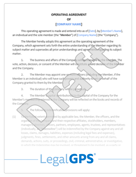Should a Copywriter Use a Contract for Deliverables?
You’ve just poured weeks into crafting perfect website copy for a client. You hit send, expecting praise and payment. Instead, the client demands...
6 min read
LegalGPS : Jul. 14, 2025
You’ve just delivered a 15,000-word translation of a legal contract, expecting prompt payment for weeks of meticulous work. Instead, the client demands three more rounds of revisions for free, or worse, refuses to pay, claiming the work was late. Sound familiar? These headaches are all too common for freelance translators, but they’re preventable with one essential tool: a client agreement template. This legal document can protect your income, clarify project expectations, and ensure you’re treated as a professional.


Legal GPS Pro
Protect your business with our complete legal subscription service, designed by top startup attorneys.
So, should translators use a client agreement template? Absolutely. Whether you’re translating marketing materials, legal documents, or medical reports, a client agreement template for translators is your shield against non-payment, scope creep, and disputes over deadlines or revisions. In this guide, we’ll explore what a translator client contract is, why it’s critical, the key terms to include, when to use one, and how to create your own. With real-world examples and actionable pro tips, you’ll learn how to safeguard your translation business and build trust with clients. Let’s dive in.
A client agreement template is a customizable legal contract between a translator and a client that outlines the terms of translation services, including the scope of work, payment details, deadlines, and other conditions. It serves as a roadmap to ensure both parties understand the project’s expectations, preventing misunderstandings that can lead to disputes or unpaid invoices.
For translators, whose work often involves tight deadlines, complex projects, and demanding clients, a contract is non-negotiable. Without a freelance translator agreement, you’re vulnerable to risks like clients requesting extra work for free, delaying payments, or disputing the quality of your translations. A well-crafted agreement protects your income, sets professional boundaries, and demonstrates your commitment to clear communication. It’s not just about avoiding conflicts—it’s about building a sustainable translation career.
Meet Alex, a freelance translator who completes a 10,000-word user manual for a tech company. The client agreed to pay $2,000 upon delivery, but after submission, they refuse, claiming the work was late by a day. Without a contract, Alex has no proof of the agreed deadline or payment terms, losing the entire fee. A client agreement template with clear payment and deadline clauses would have ensured Alex was paid on time, backed by a legally binding document.
Don’t draft from scratch. A customizable translation services contract template from Legal GPS is attorney-drafted and tailored for translators. It covers all the essentials, saving you time and ensuring your contract is legally sound.
A strong translator client contract is your defense against common freelance challenges. Here are the must-have terms to include:

Service Agreement Template
Download our general Service Agreement Template to streamline client onboarding and protect your services with clear terms.
Trusted by 1,000+ businesses to safeguard their LLCs.
These terms address the biggest pain points for translators, from scope creep to non-payment. For sensitive projects (e.g., legal or medical translations), ensure the contract complies with industry-specific regulations, such as HIPAA for medical translations in the U.S.
Sarah, a translator, delivers a marketing brochure translation from French to English. The client demands four additional rounds of revisions, citing “style preferences,” without extra pay. Without a contract, Sarah spends unpaid hours revising. A contract limiting revisions to one round and charging $50 per additional round would have ensured Sarah was compensated and kept the project manageable.
Avoid endless tweaks by specifying a set number of revisions in your contract—typically one or two rounds for most projects. Include a clause charging extra for additional revisions (e.g., $50 per round or 10% of the project fee). This keeps clients focused and ensures you’re paid for extra work.
You might think contracts are only for large agencies or high-value projects, but that’s a myth.


Legal GPS Pro
Protect your business with our complete legal subscription service, designed by top startup attorneys.
A client agreement template for translators is critical in these scenarios:
Some translators believe “emails are sufficient” or “small projects don’t need contracts.” In reality, even a $200 translation can lead to disputes, and emails are hard to enforce legally. A contract also builds client trust by showcasing your professionalism, encouraging repeat business and referrals.
Jake, a translator, agrees to translate a website’s homepage from German to English. Midway through, the client asks him to edit the source content for clarity, claiming it’s “part of the job.” Without a contract, Jake spends unpaid hours editing. A contract defining the scope as “translation of 1,000 words, no source editing” would have prevented the extra work and ensured fair compensation.
Require a client agreement for every project, even small or one-off translations, to maintain consistency and protect your business. A standard contract process saves time and ensures you’re covered, no matter the project size.
Creating a translator client contract is simpler than you think. Follow these steps:
When presenting the contract, frame it as a standard practice: “This agreement ensures we’re aligned on the project scope and timeline, so we can focus on delivering a high-quality translation.” This approach minimizes pushback and builds trust.
Emma, a freelance translator, started using a Legal GPS contract for all clients. For a recent legal document translation, she sent a contract outlining the scope (3,000 words, one revision), payment terms (50% upfront), and confidentiality clauses. The client appreciated her clarity, signed promptly, and later hired her for a six-month contract. The contract protected Emma and strengthened her client relationship.
Streamline your process with e-signature tools like DocuSign or HelloSign. These platforms let clients sign contracts digitally, save time, and keep your records organized for tax season or disputes.
Even experienced translators can stumble with contracts. Here are common pitfalls and how to avoid them:
Legal GPS templates are designed with clear, compliant language to avoid these issues, but review your contract annually or for new services.
Tom, a translator, used a contract but vaguely stated “delivery in July.” The client expected the work by July 1, while Tom planned for July 15, leading to a dispute and delayed payment. A contract with a specific deadline (e.g., “delivery by July 15, 2025, 5:00 PM EST”) would have prevented the misunderstanding and ensured timely payment.
Update your translation contract template annually or per project to reflect new services, rates, or legal requirements (e.g., data protection laws for EU clients). This keeps your contracts relevant and maximizes their protective power.
A client agreement template for translators is more than paperwork—it’s your lifeline as a freelancer. By defining the scope, securing payments, limiting revisions, and protecting confidentiality, it shields you from non-payment, scope creep, and disputes. Whether you’re translating a single document or managing ongoing projects, a contract ensures you’re compensated fairly and respected as a professional.
The biggest question now is, "Do you need a lawyer for your business?” For most businesses and in most cases, you don't need a lawyer to start your business. Instead, many business owners rely on Legal GPS Pro to help with legal issues.
Legal GPS Pro is your All-In-One Legal Toolkit for Businesses. Developed by top startup attorneys, Pro gives you access to 100+ expertly crafted templates including operating agreements, NDAs, and service agreements, and an interactive platform. All designed to protect your company and set it up for lasting success.

Legal GPS Pro
Protect your business with our complete legal subscription service, designed by top startup attorneys.
|
Premium Template
Single-use Template |
Legal GPS Pro
Unlimited Access, Best Value |
|
|
| Choose Template | Learn More |
| Trusted by 1000+ businesses | |
Table of Contents

You’ve just poured weeks into crafting perfect website copy for a client. You hit send, expecting praise and payment. Instead, the client demands...

Picture this: You’re a freelance designer who just delivered a stunning logo for a client. They love it—until they demand five more rounds of...

Imagine this: You’re a social media manager who just launched a killer Instagram campaign for a client. The posts are racking up likes, but when you...